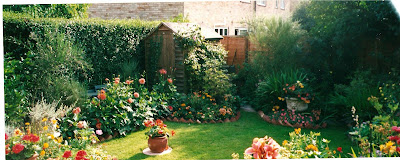DON'T TOUCH MY FLAGS
“Don’t touch my flags” was an oft repeated warning of my father in the days when his irises, ranged along the top of the garden beside the back gate, were at the peak of their flowering prowess. I have little doubt that the last thing on the mind of a ten year old on those unfettered days in early summer was interfering with his flowers, but of all the features of his garden he obviously felt very protective of them and they were a source of great pride. And rightly so as they can be cantankerous and uncooperative, and if he’d managed to get an entire bed into bloom he’d naturally want to preserve them for as long as they were in their prime.
Since those long ago summers of my father’s garden, the iris has undergone an entire transformation, not merely in name but also through breeding development and hybridisation there are now so many more varieties and exciting colour combinations available. Much more so than anything my father had or could ever have imagined. He had only one common sort which was then the norm and despite his satisfaction with them, quite prosaic by comparison with the diverse range on offer today.
I have to be careful when writing this post to rein it in a bit and not to run too freely to every exaggerated adjective available. Such as proclaiming that they illuminate and irradiate with their velveteen blush or that they sway majestically above everything else displaying their delicate, quivery furry tufts (beard). Or that known as they are to be the personification of the rainbow their timeless beauty can soothe your 21st century soul like a metaphysical balm.
No, of course I won’t do any of that, but merely to say that these are undoubtedly my favourite flowers, in fact probably my most favourite anything. They’re head and shoulders above literally everything else and I could extol their virtues all day. To me a garden’s just not a garden without them.
And what is helpful to know is that the Goddess ‘Iris’ in Greek Mythology was the
divine messenger of the Gods. She travelled on the arc of the rainbow delivering
messages between the earth, the sea and the sky. So you see when you gaze on the splendour of
an iris in bloom what you’re seeing is not just a form unparalleled anywhere
in nature but something intrinsically magical and mythical which has a special
indefinable something that transcends time.
Beginners Guide
First thing to know is that they resent being in a pot. They will punish you for this offence by almost certainly
never flowering if left there.
When you get them they’ll come either as a rhizome from a pack with no
foliage or in a deep pot from the garden centre.
Either way you need to plant with the rhizome sitting on top of the soil. This is because, to flower, they need to feel the sun on that exposed rhizome. If it’s buried below the earth they’ll rot off.
Either way you need to plant with the rhizome sitting on top of the soil. This is because, to flower, they need to feel the sun on that exposed rhizome. If it’s buried below the earth they’ll rot off.
Secondly, on the underside they’ll be some long hairy roots, try and position and spread these out to the maximum depth possible as these are the tap root or roots and these forage deeply for water sources.
Also important is to have them in as much prolonged sunshine as
possible. Never plant them in shade if
you want a long and happy life together.
It’s also worth considering if you’re going to put them in a mixed bed
or isolate them by themselves. The
problem with incorporating them among other plants is that the other plants can
develop and spread across the iris’s rhizome, thereby eradicating any sunlight
and so diminishing the iris’s ability to thrive in the requisite conditions. I know I’ll get comments about this as many
will say that they’ve had much success with their irises in their mixed beds
but for me, a singular bed devoted to irises is such a spectacular sight, it’s worth separating
them and then you can concentrate on keeping them weed free. OK, so you only get them in flower for maybe
three weeks out of the entire year, so I’ll have to leave it up to you to
decide if you feel that’s a worthwhile sacrifice.
Another advantage of segregation is that you get to really monitor the watering. This is important if you’re giving your mixed borders a daily dousing as irises only need watering once a week or maybe twice if the temperature rises above the mid 20s. The reason for this is that those long tap roots will be running deep, anchoring them in place while searching out hidden water at the same time. Overwatering is another common mistake that can lead to an untimely end.
The last thing to know is that after flowering you can tidy up the leaves by cutting them into this fan shape formation. The tips will dry out a bit but it won’t do them any harm, it looks pretty smart and is thought that by reducing the height stops them rocking around in the wind and putting stress and leverage on the root system.
Well, that's about it, as this is not really a subject for a blog post, it's more a subject for a lifetime of discovery. So to recap. What have we learned? Get some irises into your life. Basically that’s it and it’s a decision you won’t regret.
ANYWAY, AS THEY SAY AROUND HERE
You have been warned!!!














































